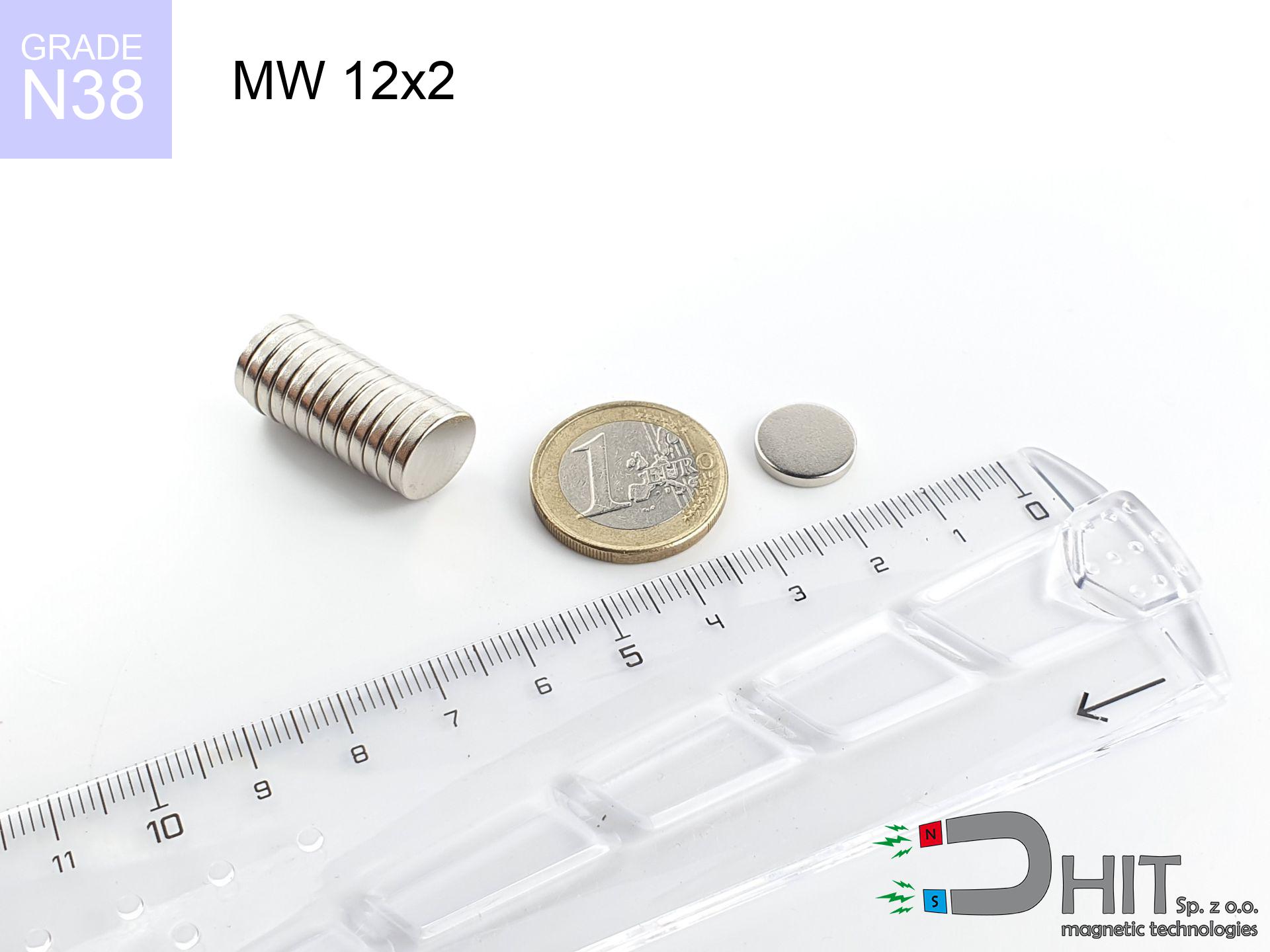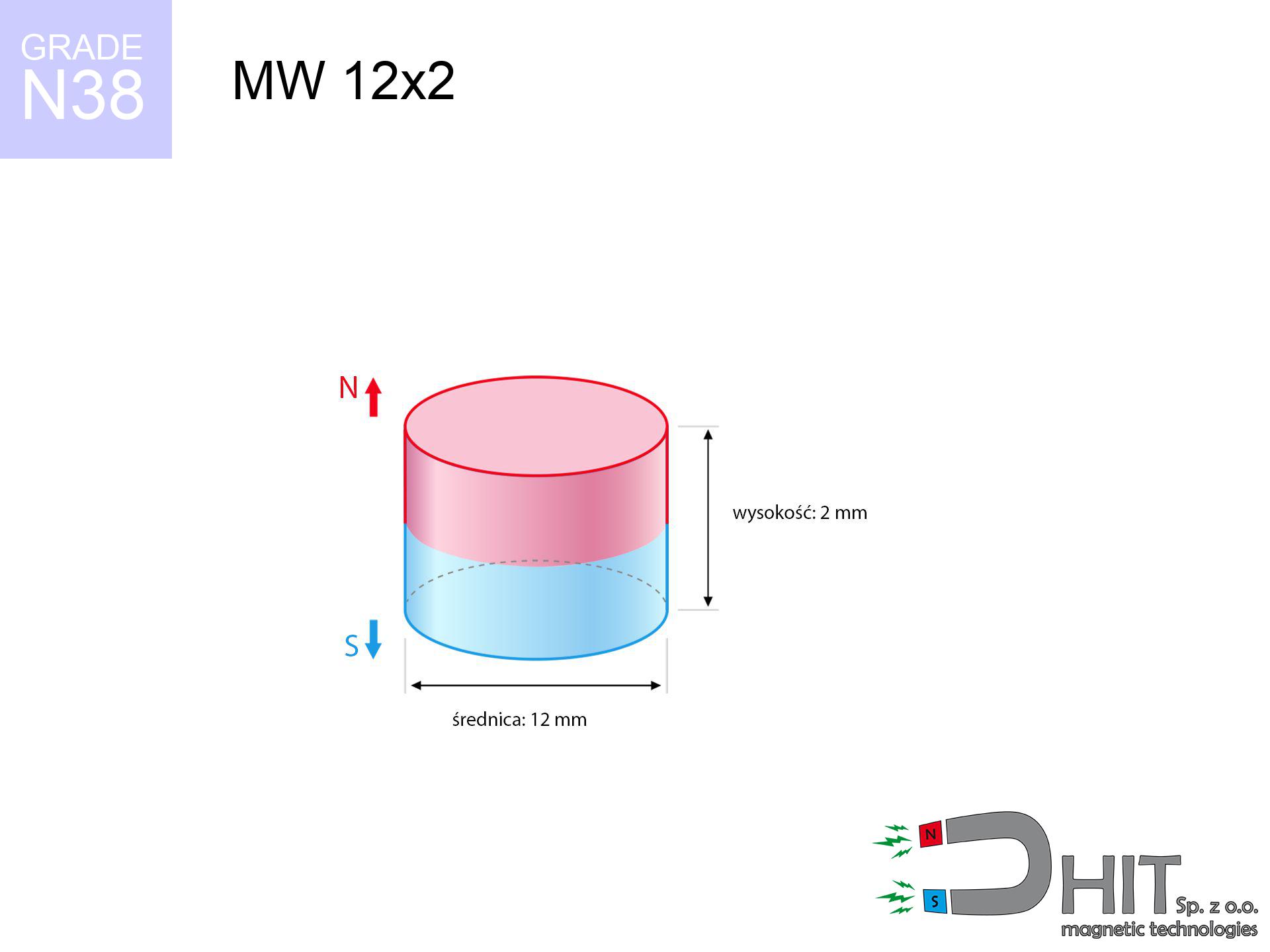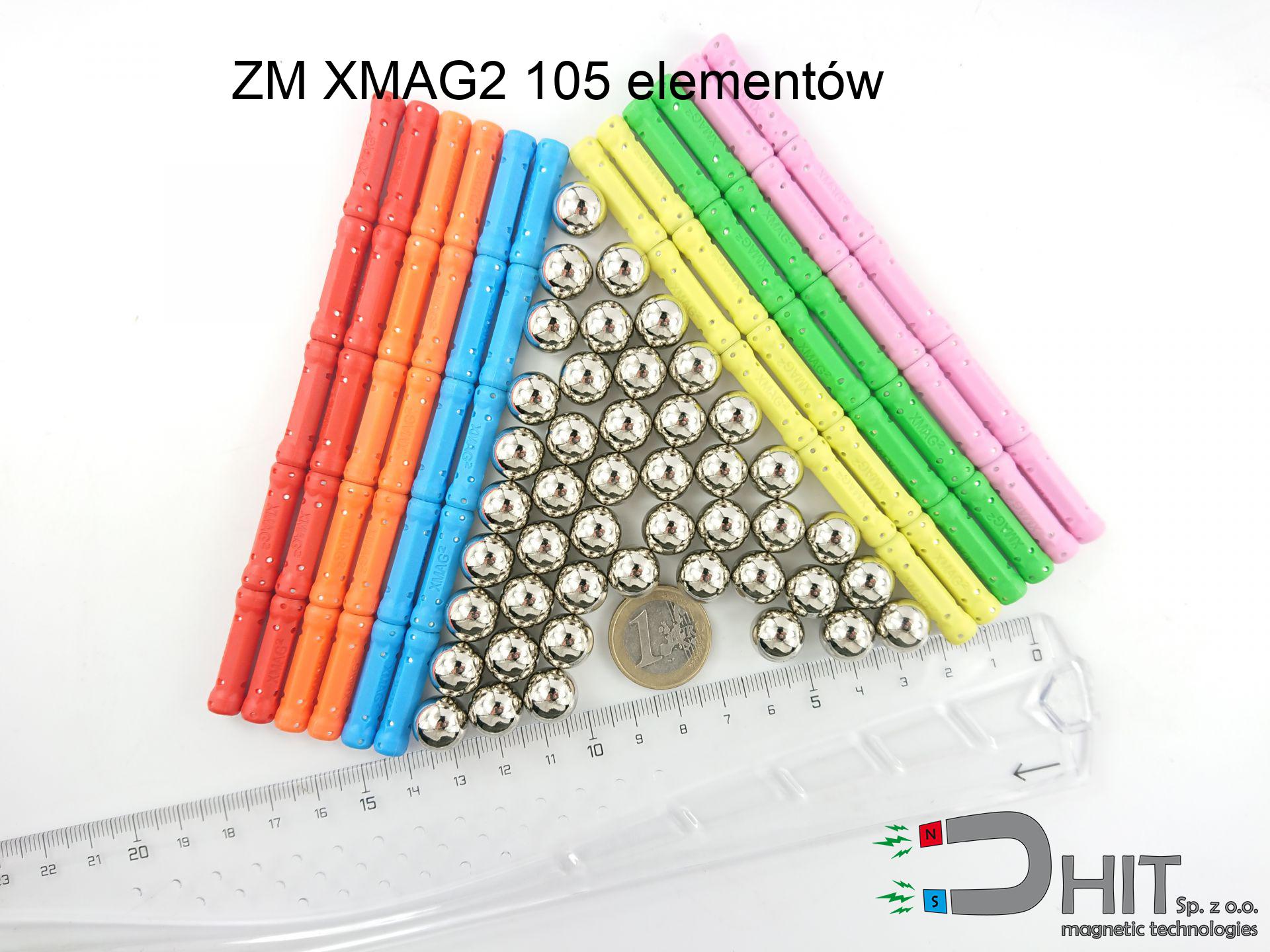MW 12x2 / N38 - cylindrical magnet
cylindrical magnet
Catalog no 010017
GTIN: 5906301810162
Diameter Ø
12 mm [±0,1 mm]
Height
2 mm [±0,1 mm]
Weight
1.7 g
Magnetization Direction
↑ axial
Load capacity
1.19 kg / 11.68 N
Magnetic Induction
195.97 mT
Coating
[NiCuNi] Nickel
1.132 ZŁ with VAT / pcs + price for transport
0.920 ZŁ net + 23% VAT / pcs
bulk discounts:
Need more?Hunting for a discount?
Call us
+48 22 499 98 98
or let us know via
contact form
our website.
Parameters and shape of magnets can be checked using our
our magnetic calculator.
Orders submitted before 14:00 will be dispatched today!
MW 12x2 / N38 - cylindrical magnet
Specification / characteristics MW 12x2 / N38 - cylindrical magnet
| properties | values |
|---|---|
| Cat. no. | 010017 |
| GTIN | 5906301810162 |
| Production/Distribution | Dhit sp. z o.o. |
| Country of origin | Poland / China / Germany |
| Customs code | 85059029 |
| Diameter Ø | 12 mm [±0,1 mm] |
| Height | 2 mm [±0,1 mm] |
| Weight | 1.7 g |
| Magnetization Direction | ↑ axial |
| Load capacity ~ ? | 1.19 kg / 11.68 N |
| Magnetic Induction ~ ? | 195.97 mT |
| Coating | [NiCuNi] Nickel |
| Manufacturing Tolerance | ±0.1 mm |
Magnetic properties of material N38
| properties | values | units |
|---|---|---|
| remenance Br [Min. - Max.] ? | 12.2-12.6 | kGs |
| remenance Br [Min. - Max.] ? | 1220-1260 | T |
| coercivity bHc ? | 10.8-11.5 | kOe |
| coercivity bHc ? | 860-915 | kA/m |
| actual internal force iHc | ≥ 12 | kOe |
| actual internal force iHc | ≥ 955 | kA/m |
| energy density [Min. - Max.] ? | 36-38 | BH max MGOe |
| energy density [Min. - Max.] ? | 287-303 | BH max KJ/m |
| max. temperature ? | ≤ 80 | °C |
Physical properties of sintered neodymium magnets Nd2Fe14B at 20°C
| properties | values | units |
|---|---|---|
| Vickers hardness | ≥550 | Hv |
| Density | ≥7.4 | g/cm3 |
| Curie Temperature TC | 312 - 380 | °C |
| Curie Temperature TF | 593 - 716 | °F |
| Specific resistance | 150 | μΩ⋅Cm |
| Bending strength | 250 | Mpa |
| Compressive strength | 1000~1100 | Mpa |
| Thermal expansion parallel (∥) to orientation (M) | (3-4) x 106 | °C-1 |
| Thermal expansion perpendicular (⊥) to orientation (M) | -(1-3) x 10-6 | °C-1 |
| Young's modulus | 1.7 x 104 | kg/mm² |
Engineering modeling of the product - data
Presented information constitute the direct effect of a engineering analysis. Values are based on models for the material NdFeB. Real-world parameters may differ from theoretical values. Please consider these calculations as a reference point when designing systems.
MW 12x2 / N38
| Distance (mm) | Induction (Gauss) / mT | Pull Force (kg) | Risk Status |
|---|---|---|---|
| 0 mm |
1959 Gs
195.9 mT
|
1.19 kg / 1190.0 g
11.7 N
|
low risk |
| 1 mm |
1753 Gs
175.3 mT
|
0.95 kg / 953.3 g
9.4 N
|
low risk |
| 2 mm |
1479 Gs
147.9 mT
|
0.68 kg / 677.8 g
6.6 N
|
low risk |
| 5 mm |
738 Gs
73.8 mT
|
0.17 kg / 169.0 g
1.7 N
|
low risk |
| 10 mm |
229 Gs
22.9 mT
|
0.02 kg / 16.3 g
0.2 N
|
low risk |
| 15 mm |
90 Gs
9.0 mT
|
0.00 kg / 2.5 g
0.0 N
|
low risk |
| 20 mm |
43 Gs
4.3 mT
|
0.00 kg / 0.6 g
0.0 N
|
low risk |
| 30 mm |
14 Gs
1.4 mT
|
0.00 kg / 0.1 g
0.0 N
|
low risk |
| 50 mm |
3 Gs
0.3 mT
|
0.00 kg / 0.0 g
0.0 N
|
low risk |
MW 12x2 / N38
| Surface type | Friction coefficient / % Mocy | Max load (kg) |
|---|---|---|
| Raw steel |
µ = 0.3
30% Nominalnej Siły
|
0.36 kg / 357.0 g
3.5 N
|
| Painted steel (standard) |
µ = 0.2
20% Nominalnej Siły
|
0.24 kg / 238.0 g
2.3 N
|
| Oily/slippery steel |
µ = 0.1
10% Nominalnej Siły
|
0.12 kg / 119.0 g
1.2 N
|
| Magnet with anti-slip rubber |
µ = 0.5
50% Nominalnej Siły
|
0.60 kg / 595.0 g
5.8 N
|
MW 12x2 / N38
| Steel thickness (mm) | % power | Real pull force (kg) |
|---|---|---|
| 0.5 mm |
|
0.12 kg / 119.0 g
1.2 N
|
| 1 mm |
|
0.30 kg / 297.5 g
2.9 N
|
| 2 mm |
|
0.60 kg / 595.0 g
5.8 N
|
| 5 mm |
|
1.19 kg / 1190.0 g
11.7 N
|
| 10 mm |
|
1.19 kg / 1190.0 g
11.7 N
|
MW 12x2 / N38
| Ambient temp. (°C) | Power loss | Remaining pull | Status |
|---|---|---|---|
| 20 °C | 0.0% |
1.19 kg / 1190.0 g
11.7 N
|
OK |
| 40 °C | -2.2% |
1.16 kg / 1163.8 g
11.4 N
|
OK |
| 60 °C | -4.4% |
1.14 kg / 1137.6 g
11.2 N
|
OK |
| 80 °C | -6.6% |
1.11 kg / 1111.5 g
10.9 N
|
|
| 100 °C | -28.8% |
0.85 kg / 847.3 g
8.3 N
|
MW 12x2 / N38
| Gap (mm) | Attraction (kg) (N-S) | Repulsion (kg) (N-N) |
|---|---|---|
| 0 mm |
1.79 kg / 1785.0 g
17.5 N
|
N/A |
| 2 mm |
1.02 kg / 1020.0 g
10.0 N
|
0.95 kg / 952.0 g
9.3 N
|
| 5 mm |
0.26 kg / 255.0 g
2.5 N
|
0.24 kg / 238.0 g
2.3 N
|
| 10 mm |
0.03 kg / 30.0 g
0.3 N
|
0.03 kg / 28.0 g
0.3 N
|
| 20 mm |
0.00 kg / 0.0 g
0.0 N
|
0.00 kg / 0.0 g
0.0 N
|
| 50 mm |
0.00 kg / 0.0 g
0.0 N
|
0.00 kg / 0.0 g
0.0 N
|
MW 12x2 / N38
| Object / Device | Limit (Gauss) / mT | Safe distance |
|---|---|---|
| Pacemaker | 5 Gs (0.5 mT) | 4.5 cm |
| Hearing aid | 10 Gs (1.0 mT) | 3.5 cm |
| Timepiece | 20 Gs (2.0 mT) | 3.0 cm |
| Phone / Smartphone | 40 Gs (4.0 mT) | 2.5 cm |
| Remote | 50 Gs (5.0 mT) | 2.0 cm |
| Payment card | 400 Gs (40.0 mT) | 1.0 cm |
| HDD hard drive | 600 Gs (60.0 mT) | 1.0 cm |
MW 12x2 / N38
| Start from (mm) | Speed (km/h) | Energy (J) | Predicted outcome |
|---|---|---|---|
| 10 mm |
26.91 km/h
(7.47 m/s)
|
0.05 J | |
| 30 mm |
46.22 km/h
(12.84 m/s)
|
0.14 J | |
| 50 mm |
59.66 km/h
(16.57 m/s)
|
0.23 J | |
| 100 mm |
84.38 km/h
(23.44 m/s)
|
0.47 J |
MW 12x2 / N38
| Technical parameter | Value / Description |
|---|---|
| Coating type | [NiCuNi] Nickel |
| Layer structure | Nickel - Copper - Nickel |
| Layer thickness | 10-20 µm |
| Salt spray test (SST) ? | 24 h |
| Recommended environment | Indoors only (dry) |
MW 12x2 / N38
| Environment | Effective steel pull | Effect |
|---|---|---|
| Air (land) | 1.19 kg | Standard |
| Water (riverbed) |
1.36 kg
(+0.17 kg Buoyancy gain)
|
+14.5% |
See more offers
Advantages and disadvantages of NdFeB magnets.
Besides their magnetic performance, neodymium magnets are valued for these benefits:
- They virtually do not lose power, because even after 10 years the performance loss is only ~1% (in laboratory conditions),
- They show high resistance to demagnetization induced by external magnetic fields,
- Thanks to the reflective finish, the surface of nickel, gold, or silver-plated gives an visually attractive appearance,
- The surface of neodymium magnets generates a maximum magnetic field – this is a key feature,
- Due to their durability and thermal resistance, neodymium magnets are capable of operate (depending on the shape) even at high temperatures reaching 230°C or more...
- In view of the ability of precise forming and adaptation to custom projects, neodymium magnets can be produced in a wide range of forms and dimensions, which amplifies use scope,
- Universal use in electronics industry – they are used in magnetic memories, electric motors, medical devices, also multitasking production systems.
- Compactness – despite small sizes they provide effective action, making them ideal for precision applications
Cons of neodymium magnets and ways of using them
- They are prone to damage upon heavy impacts. To avoid cracks, it is worth securing magnets in a protective case. Such protection not only shields the magnet but also improves its resistance to damage
- When exposed to high temperature, neodymium magnets suffer a drop in power. Often, when the temperature exceeds 80°C, their power decreases (depending on the size, as well as shape of the magnet). For those who need magnets for extreme conditions, we offer [AH] versions withstanding up to 230°C
- Due to the susceptibility of magnets to corrosion in a humid environment, we recommend using waterproof magnets made of rubber, plastic or other material stable to moisture, when using outdoors
- Due to limitations in producing nuts and complex forms in magnets, we recommend using a housing - magnetic mount.
- Potential hazard to health – tiny shards of magnets are risky, in case of ingestion, which becomes key in the context of child health protection. Furthermore, small elements of these magnets are able to disrupt the diagnostic process medical in case of swallowing.
- Higher cost of purchase is a significant factor to consider compared to ceramic magnets, especially in budget applications
Optimal lifting capacity of a neodymium magnet – what contributes to it?
Holding force of 1.19 kg is a measurement result conducted under standard conditions:
- with the application of a yoke made of special test steel, ensuring maximum field concentration
- possessing a thickness of at least 10 mm to ensure full flux closure
- with a plane free of scratches
- without any air gap between the magnet and steel
- under vertical force vector (90-degree angle)
- at standard ambient temperature
Lifting capacity in practice – influencing factors
Real force is affected by specific conditions, including (from priority):
- Distance – existence of foreign body (paint, dirt, air) acts as an insulator, which reduces power rapidly (even by 50% at 0.5 mm).
- Force direction – declared lifting capacity refers to pulling vertically. When attempting to slide, the magnet exhibits much less (typically approx. 20-30% of nominal force).
- Base massiveness – insufficiently thick steel does not accept the full field, causing part of the power to be lost into the air.
- Steel type – mild steel gives the best results. Higher carbon content decrease magnetic properties and holding force.
- Surface structure – the more even the surface, the better the adhesion and stronger the hold. Unevenness creates an air distance.
- Thermal conditions – neodymium magnets have a sensitivity to temperature. When it is hot they are weaker, and at low temperatures they can be stronger (up to a certain limit).
* Lifting capacity testing was carried out on plates with a smooth surface of suitable thickness, under perpendicular forces, whereas under attempts to slide the magnet the holding force is lower. Moreover, even a minimal clearance {between} the magnet’s surface and the plate lowers the lifting capacity.
Precautions when working with neodymium magnets
Pinching danger
Protect your hands. Two powerful magnets will snap together immediately with a force of several hundred kilograms, destroying everything in their path. Be careful!
Adults only
Strictly keep magnets out of reach of children. Ingestion danger is high, and the effects of magnets connecting inside the body are fatal.
Handling guide
Handle magnets consciously. Their immense force can shock even experienced users. Stay alert and do not underestimate their power.
Combustion hazard
Machining of neodymium magnets carries a risk of fire hazard. Neodymium dust oxidizes rapidly with oxygen and is hard to extinguish.
Data carriers
Avoid bringing magnets close to a purse, computer, or screen. The magnetic field can irreversibly ruin these devices and wipe information from cards.
Threat to navigation
Remember: rare earth magnets produce a field that interferes with sensitive sensors. Keep a safe distance from your mobile, device, and navigation systems.
Medical implants
Patients with a pacemaker should maintain an large gap from magnets. The magnetic field can disrupt the functioning of the life-saving device.
Heat sensitivity
Standard neodymium magnets (N-type) undergo demagnetization when the temperature surpasses 80°C. Damage is permanent.
Skin irritation risks
Allergy Notice: The nickel-copper-nickel coating contains nickel. If an allergic reaction happens, immediately stop working with magnets and wear gloves.
Shattering risk
Beware of splinters. Magnets can explode upon uncontrolled impact, ejecting sharp fragments into the air. Eye protection is mandatory.
Danger!
Learn more about hazards in the article: Safety of working with magnets.




![AM ucho [M8] - magnetic accessories AM ucho [M8] - magnetic accessories](https://cdn3.dhit.pl/graphics/products/am-ucho-m8-lib.jpg)
![UMGGW 29x8 [M4] GW / N38 - magnetic holder rubber internal thread UMGGW 29x8 [M4] GW / N38 - magnetic holder rubber internal thread](https://cdn3.dhit.pl/graphics/products/umg-29x8-m4-gw-duf.jpg)

![UMP 107x40 [M8+M10] GW F400 Lina / N38 - search holder UMP 107x40 [M8+M10] GW F400 Lina / N38 - search holder](https://cdn3.dhit.pl/graphics/products/ump-107x40-m8+m10-gw-f400-+lina-bel.jpg)

